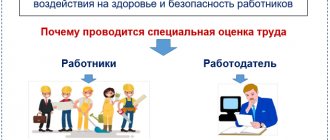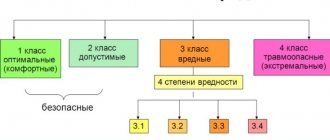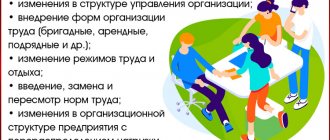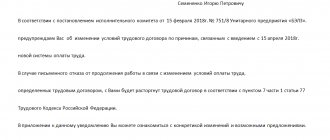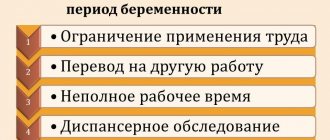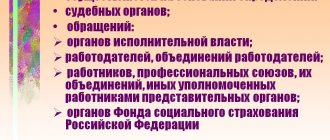Special assessment of working conditions is a single set of consistently implemented measures to identify harmful and (or) dangerous factors in the working environment and the labor process, and assess the level of their impact on the employee (Article 3 of the Federal Law of December 28, 2013 N 426-FZ “On the special assessment of conditions labor") (hereinafter referred to as Law No. 426-FZ).
The order of the Ministry of Labor of Russia dated January 24, 2014 approved a methodology for assessing working conditions in organizations, a classifier that combines all harmful and dangerous factors that can affect the health of workers and report forms for conducting a special assessment of working conditions and instructions for filling it out.
Do I need an order to conduct a special assessment of working conditions?
The Law “On Special Assessment of Working Conditions” dated December 28, 2013 No. 426-FZ does not directly indicate that the employer must issue an order for a special assessment of working conditions, but it requires organizing a number of activities, the fact of which is usually reflected in administrative documents ( orders, instructions).
The legislation does not approve the form of such an order (instruction), so it can be made in free form.
The order must contain the following details:
- Full name of the employer.
- Date and order number.
- A preamble in which a reference is made to the regulatory document according to which the SOUT is carried out.
- Text of the order.
- Manager's signature.
- Seal.
The order is drawn up in several copies (or copies are made). One is filed in the order book, the other, along with other documents, is handed over to the organization that will conduct the inspection.
How are working conditions assessed?
In order to properly assess working conditions, the first step in the organization is to issue an appropriate order. Through it, a special commission is appointed, which may include not only company employees, but also representatives of specialized expert services. Next, production is visited, the necessary measurements are taken, which are compared with the standards established by law, and based on their results, unfavorable factors are identified.
To complete the assessment of working conditions, an order is also issued, summarizing the results of the procedure, prescribing measures to eliminate the violations found, and appointing responsible persons. In addition, all employees of the enterprise must be familiarized with the results of the commission’s activities against signature.
It should be noted that the assessment of working conditions should be carried out at certain intervals, but at least once every five years. If this norm is violated, the management of the organization, and indeed the legal entity itself, may be subject to serious administrative punishment.
https://youtu.be/0o1suNKDDmE
Formation of a commission for a special assessment of working conditions
Commission special assessment of working conditions, according to Art. 9 of Law No. 426-FZ), consists of representatives of the employer of the organization, a labor protection specialist, as well as a representative from a trade union or other authorized body.
In special cases, the head of the commission may not be the employer, but his representative. The total number of all members of this commission must be odd. The best option is 5-7 people.
To check working conditions in an organization, you need to: create your own commission; issue an order for its creation, and each participant must sign this order.
It is important to remember that a special assessment of working conditions is carried out at enterprises every 5 years. Some jobs are not verified. These are workers who work from home, workers of religious organizations, and remote workers. Before the commission begins the assessment, it is necessary to approve all workplaces, as well as indicate places with similar working conditions.
Based on the commission's assessment, dangerous and hazardous work areas will be identified. For such conditions, the employer must pay an additional insurance contribution rate to the Pension Fund, which ranges from 2 to 8%.
Unscheduled special assessment
In addition to the planned special assessment of jobs in the company, in some cases you must also conduct an unscheduled assessment. It is carried out when new workplaces are put into operation, the technological process changes, and an order is received from the labor inspector. This requirement is established in Part 1 of Article 17 of Law No. 426-FZ.
The period during which an unscheduled special assessment of working conditions must be carried out ranges from 6 to 12 months, depending on the basis for its conduct. This period is established by Part 2 of Article 17 of Law No. 426-FZ.
Order to create a commission: nuances
An example of an order to create a commission for a special assessment of working conditions can be found in the “Practical Materials” blog section. Based on it, you can create your own documentation, taking into account the most common mistakes that are made when drawing up this order. It is also worth noting that the order must be on the organization’s letterhead. Thanks to the work of the commission, measures will be taken and schemes will be developed that will improve jobs in the organization.
An approximate structure of such an order might look like this:
SOUTH Regulations for the Enterprise
2) the presence in the organization of at least five experts working under an employment contract and having an expert certificate for the right to perform work on a special assessment of working conditions, including at least one expert who has a higher education in one of the specialties - a general hygiene doctor, a doctor in occupational hygiene, doctor for sanitary and hygienic laboratory research;
Of course, I do not rule out the option when the certifying organization is chosen based on price - the lowest price is increasingly becoming the main argument, but is it worth it? Previously, certification was treated as a mandatory “paper” that must be shown to the regulatory authority.
Now the Special Assessment Card is a document on the basis of which many financial issues are decided. If you are given a pile of papers with many errors, inaccuracies and incorrect data, then the Report loses the status of a document and the employer is left alone with the state inspectorate, the social insurance fund, the pension fund, etc.
Moreover, penalties and the need to re-conduct a special assessment may be added to this.
Regulations on special assessment of working conditions
From January 1, 2014, all employers are required to conduct a special assessment of working conditions in workplaces, which was introduced instead of the previously existing certification of workplaces to determine the harmful and dangerous factors affecting workers. What is the judicial practice on this issue?
Conducting a special assessment of working conditions is mandatory for all types of enterprises of any specific activity.
However, questions arise about carrying out this procedure in the office, because there seem to be no harmful factors here.
What conditions are taken into account and how is the special assessment carried out for office staff? How to organize it and how to complete all the necessary documents? This article provides an example of step-by-step actions.
Sample regulations on the implementation of SOUT in an organization
As mentioned earlier, a regulation on a special assessment of working conditions is developed independently by the employer and, like all local documents, is approved by the manager. Since the legislation has not established a standard model, when drawing up an act it is advisable to use the provisions of Law No. 426-FZ.
The regulation on SOUT in the organization - its sample is not established by law, therefore this document is developed by each enterprise independently. What regulations can be used when drawing up a regulation, what its approximate content might be, we will describe in detail in the article below.
Special assessment of working conditions: general provisions
- The subject of the Agreement is the provision by the Contractor of legal services, namely legal advice on legal issues of interest to the Customer in the field of healthcare.
- Legal services are provided to the Customer in accordance with the list and cost of services specified in the Contractor’s Price List, valid at the time of acceptance of the offer by the Customer.
- For the provision of legal services under the Agreement, the Customer pays the Contractor a fee in the manner specified in sections 4 and 6 of the Agreement and specified in the order specifications.
- Legal services are provided in the form of oral or written consultation.
- Legal services in the form of oral consultation are provided at the location of the Contractor (125252, Moscow, Alabyana St., 13, building 1) or remotely using various means of remote consultation, in particular: telephone or IP communication, other types modern communications (Skype, WhatsApp, Viber, others), allowing oral communication between the parties.
- Legal services in the form of oral consultation may be provided in another place, which is agreed upon by the Parties by any available means.
- Legal services in the form of a written consultation can be provided either deferred or online. After receiving a written consultation, the Customer has the right, within 15 calendar days, to receive the Contractor’s explanations orally within 15 minutes. If you wish to receive clarification beyond the specified time, the Customer has the right to receive a paid consultation under the terms of these Rules.
- Consultation in a deferred mode involves the preparation by the Contractor of a written response to a strictly defined question(s) of the Customer. The response is prepared in Russian in word and (or) pdf format and is attached to the order information in the Customer’s personal account. At the Customer's request, the response may be sent to his e-mail or transmitted to him in other ways available and free for the Contractor.
- Written online consultation is provided via email or using other electronic services (Skype, WhatsApp, Viber, others).
- The date and time of provision of legal services, form, type and mode of consultation, its duration, cost and other conditions for the provision of legal services are determined in the order characteristics in your personal account.
Order on the creation of a commission for a special assessment of working conditions (sample form)
Name of company
Order
About the commission for conducting a special assessment of working conditions
In order to organize work on conducting a special assessment of working conditions (hereinafter referred to as SOUT), in accordance with the requirements of Article 212 of the Labor Code of the Russian Federation, and the Federal Law of December 28, 2013 No. 426-FZ “On the special assessment of working conditions”,
I ORDER:
1.Create a commission for carrying out special assessment and assessment (hereinafter referred to as the Commission) with the following composition:
Chairman of the commission: Head of the organization
Deputy Chairman of the Commission: Deputy Head of the Organization
Members of the commission: Occupational safety specialist, HR specialist, representative of a trade union organization or representative body of workers. Deadline…..Executor….
2. The commission will begin a special assessment of the conditions in (name of organization) from (date) to (date). Deadline…..Executor….
3. Approve the schedule for carrying out the SOUT (Appendix No. 1 for 1 sheet, 1 copy).
4. Develop and approve by the commission a list of workplaces at which a special assessment of working conditions will be carried out. Deadline…..Executor..
5. Ensure the commission is provided with the necessary materials, taking into account confidentiality, and access of testing laboratory specialists to workplaces to conduct the necessary research. Deadline…..Executor….
6. Carry out activities to conduct a special assessment of working conditions. Deadline…..Executor….
7. Provide guidance and control over the work at all stages. Deadline…..Executor….
8. Organize, as necessary, meetings of the commission in order to timely eliminate the identified comments and bring the parameters of dangerous and harmful production factors in the workplace in accordance with the requirements of GOST, rules and regulations on labor protection and other regulatory documentation. Deadline…..Executor…..
9. Based on the results of a special assessment of working conditions, ensure:
- development of a List of recommended measures to improve working conditions;
- preparation of information on compensation for workers employed in work with harmful and (or) dangerous working conditions.
- posting on its official website on the Internet information and telecommunications network summary data on the results of a special assessment of working conditions in terms of establishing classes (subclasses) of working conditions in the workplace and a list of measures to improve the conditions and labor protection of workers in whose workplaces it was carried out special assessment of working conditions. Deadline…..Executor…..
10. Appoint (job title, full name) responsible for storing documentation for a special assessment of working conditions.
11. I reserve control over the implementation of this order.
Manager ____signature______________full name
not in our state"
Projecting onto SOUT: “My neighbor had a labor inspection check, but she bypassed me, you can breathe a sigh of peace.” Moral: even if it wasn’t there today, tomorrow the time will come when you will find yourself in your neighbor’s place. And then you will not be able to avoid penalties for failure to conduct and for failure to submit the results of the SOUT in a timely manner. The fines today are considerable: the minimum is 60 thousand rubles, the maximum is 200 thousand rubles, or suspension of activities for a period of 90 days. The last option with suspension, especially for small businesses, is direct evidence of bankruptcy. Read more about the sizes and types of fines. By carrying out SOUT, you free yourself from administrative, and in some cases, criminal liability.
The approach of marketers who provide their employer with summary tables can be called far-sighted: in one - what he loses if he does not carry out SOUT, in the other - what are the costs and what are the results. Numbers and facts influence business decisions more than the legal phrase “The employer is obliged.”
What if we digitize the benefits of using SOUT results:
- Thanks to the availability of SOUT results, you can receive a discount of up to 40% on the insurance rate for accidents and occupational diseases;
- Based on the results of the special assessment, it is possible to reduce the rate of additional insurance contribution to the Pension Fund by 2% or stop paying them;
- To carry out a special assessment at 10 office workplaces, you will need, for example, 20 thousand rubles, and to pay fines if ignored - from 60 to 80 thousand rubles, plus the same 20 thousand for mandatory implementation on the instructions of the inspector (and maybe higher, i.e. .because organizations conducting SOUT are trying to earn twice as much from such clients, more details). “20” or “120” thousand – it’s your choice.
- In the event of an accident that results in serious harm or death to an employee, you will be prosecuted and sentenced to imprisonment from 1 to 3 years. Upon presentation of the results and confirmation of the compliance of working conditions in the workplace of this employee, charges against the official will be dropped partially or completely.
Requirements for the composition of the commission for conducting special assessment work in small businesses
The requirements for the composition of the commission for conducting a special assessment of working conditions in small businesses were explained by the Ministry of Labor of Russia in a letter dated October 28, 2019 N 15-4/B-2674, when conducting a special assessment at an employer classified in accordance with the legislation of the Russian Federation as a small business. working conditions, the commission may include:
- employer-individual entrepreneur (personally);
- the head of the organization and other authorized representatives of the employer, including a labor protection specialist, or a representative of the organization or a specialist engaged by the employer under a civil contract to carry out the functions of the labor protection service (labor safety specialist);
- representatives of the elected body of the primary trade union organization or other representative body of workers (if any). The number of members of the commission for conducting the special labor assessment must be odd.
Procedure for carrying out SOUT
The special assessment is carried out jointly. The employer participates in it, as well as an organization with the appropriate powers. This organization is involved in work on the basis of a civil agreement. The procedure is specified in Chapter 2 of Federal Law No. 426 of December 28, 2013. Let's consider the main stages of the procedure.
Creation of a commission on SOUT
To organize a commission, the head of a legal entity or individual entrepreneur must issue an order. Based on the document, these provisions are determined:
- Composition of the commission.
- Supervisor.
- List of works on SOUT.
- Special assessment schedule.
The law contains special requirements for the composition of the commission. In particular, the number of its participants must be odd. This is required for voting purposes. Article 9 of Federal Law No. 426 stipulates that the commission must include an employee specializing in labor protection. What to do if such an employee does not work for the company? Responsibility for labor protection can be assumed by the manager or individual entrepreneur.
Sample order for the formation of a commission to conduct special assessment and assessment
The order must contain all the necessary information to conduct a special assessment. It is on the basis of this document that the work of the commission will be carried out. Sample order:
Phoenix LLC Order No. 5
November 23, 2020
On the formation of a commission for the organization and implementation of SOUT
Based on Article 212 of the Labor Code of the Russian Federation and Federal Law No. 426 of December 28, 2013, I order:
- Form a commission to carry out the SOUTH assessment in this composition: Chairman: Petrov Vladimir Aleksandrovich, general director Members of the commission: Koksharova Natalya Eduardovna (chief accountant), Ivanov Alexander Petrovich (employee responsible for labor protection).
- Establish a schedule of activities for SOUT.
- To the Chairman: 3.1 Organize the SOUT for the period from November 23, 2020 to December 23, 2020. 3.2 Organize access for experts from the institution engaged in special assessment to workplaces and all necessary documents. 3.3 Familiarize officials with the procedure and timing of the event. 3.4 Provide me with the results of the SOUT in the form of a report by December 23 for approval.
- Heads of departments should ensure that experts have access to workplaces and all necessary information.
- I accept responsibility for fulfilling the provisions of the order.
General Director: (signature) V.A. Petrov
The order may be supplemented with attachments. Links to them must be contained in the text of the document.
What to consider when developing an order (instruction)?
- The order must have a title that expresses the main content of the document and answers the question “About what?” The title can take no more than 5 lines, 1 spaced.
- The text of the order, as a rule, consists of two parts: stating and administrative.
- The administrative part is separated from the ascertaining part by the word “I ORDER”, which is printed in capital letters and followed by a colon.
- Each paragraph of the administrative part begins with an indication of a specific action, expressed by a verb in an indefinite form - “prepare”, “organize”, “provide”, “develop” and others.
- Each paragraph indicates the performer (commission, official), the prescribed action and the deadline for execution. The performer is indicated in the dative case.
If the information was useful, leave comments and share the link to this article on your social networks. Thank you!
Reflection of information about the results of SOUT in the FSS report
Let us dwell on the reflection of the implementation of SOUT in the 4-FSS form provided to the Social Insurance Fund.
Data on the special assessment are reflected in table No. 5 of the reporting form. According to the first line of the table, in column 4 it is necessary to enter the total amount of how many jobs were covered by the special assessment.
We suggest you read: About a person’s registration using passport data: how to find out, how to check
If harmful and dangerous working conditions are identified, fill out columns 5 and 6, depending on the hazard class. In this case, it is necessary to fill out columns 7 and 8 on the second line of the table. It should be taken into account that the data is entered based on the results of the past year and does not change during the current year.
Let's give an example.
In 2020, Romashka LLC conducted a special assessment of employees’ workplaces. Taking into account the fact that the company has only 8 workplaces and some of them are similar, a special assessment was carried out in relation to 5 workplaces. No harmful working conditions were identified.
In the report for the 1st quarter of 2020 in table 5 we fill out only the first line. In column 3 you must indicate 8 people, and in column 4 - 5 people. The value of column 4 will be transferred from period to period throughout 2020 without changes.
The list of jobs for which a special assessment must be carried out, including similar ones, is determined by a commission created by the employer (Part 5 of Article 9 of Law No. 426-FZ).
A special assessment in the presence of similar jobs is carried out only in relation to 20% of their total number, but in any case there must be more than two (Part 1 of Article 16 of Law No. 426-FZ). The results of the special assessment are applied to all similar workplaces.
OUR HELP
Similar workplaces are workplaces that are located in one or more of the same type of production premises, equipped with the same or the same type of ventilation, air conditioning, heating and lighting systems, in which workers work in the same profession, position, specialty, and perform the same labor functions in the same working hours when conducting the same type of technological process using the same production equipment, tools, devices, materials and raw materials and are provided with the same personal protective equipment (Part 6 of Article 9 of Law No. 426-FZ).
When conducting a special assessment of working conditions, a specialized organization first of all identifies potentially harmful and/or dangerous production factors. The results of this identification, upon completion, are approved by a commission created by the employer (Part 2 of Article 10 of Law No. 426-FZ).
https://www.youtube.com/watch?v=ytaboutru
Then the organization begins to measure the actual values of harmful and/or dangerous factors, if any have been identified (Part 5, Article 10 of Law No. 426-FZ). Based on the results of the study, an expert from a specialized organization classifies working conditions in the workplace according to the degree of harmfulness and/or danger into optimal, acceptable, harmful and dangerous (Part 8 of Article 12, Article 14 of Law No. 426-FZ).
Based on the results of the special assessment, the organization draws up a report, which must be signed by all members of the commission created by the employer and approved by its chairman (Part 2 of Article 15 of Law No. 426-FZ). A member of the commission who does not agree with the results of a special assessment of working conditions may express his motivated opinion in writing and attach it to the report.
The report form and instructions for filling it out were approved by Order of the Ministry of Labor of Russia dated January 24, 2014 No. 33n.
Within no later than 30 calendar days from the date of approval of the report on the special assessment, the employer must familiarize employees with the results of the special assessment against signature (Part 5, Article 15 of Law No. 426-FZ). The specified period does not include periods of temporary incapacity for work of the employee, being on vacation or a business trip, or periods of rest between shifts.
Drawing up an order for a special assessment
The first document that is drawn up during the SOUT is an order for its implementation. Such an order is drawn up in free form. One of the main points of the order is the point on the appointment of a special commission.
The document contains the time frame within which the special assessment is planned to be carried out, and indicates what the members of the commission and its chairman can and must do.
In addition, the order may stipulate how to warn employees that their workplace will be assessed, as well as a list of activities carried out at the initial stage of assessment.
Thus, the order establishes the main provisions concerning the organizational aspects of conducting a special assessment. Usually two annexes are drawn up to the order :
– Appendix No. 1 – is a schedule for the assessment
– appendix No. 2 – regulates the actions of the special commission when conducting special assessment and assessment work
All documents must be approved by the head of the organization.
The final stage of the special assessment
When the main activities within the framework of the SOUT are carried out, the employer can only competently complete this procedure.
It is immediately worth noting that the organization issues an order on the results of the special assessment. It reflects information about the time frame during which the assessment was carried out, how many workplaces were analyzed and whether harmful and dangerous working conditions were identified. The order also approves measures that will help improve working conditions in the company, and assigns instructions to the heads of departments and divisions based on the results of the special assessment and assessment process.
In the process of carrying out the final procedures, it is necessary to notify the organization that carried out the special assessment about the approval of the report. Employees must be familiarized with the results of the assessment against signature. If necessary, employee employment contracts are supplemented and measures are taken to improve working conditions. In addition, information about the implementation of special assessment and assessment must be posted on the organization’s website and reflected in the report submitted to the Social Insurance Fund.

